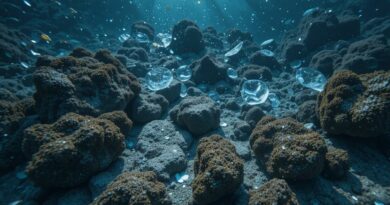Earth’s Earliest Genetic Code – New Evidence Surfaces
Groundbreaking research suggests that the building blocks of life may have emerged in a fundamentally different order than scientists previously believed
Four billion years ago, in the scalding depths of ancient Earth’s hydrothermal vents, something extraordinary was taking shape. Deep beneath the surface of a world that bore little resemblance to our own, the hypothesised common ancestral cell from which the three domains of life, the Bacteria, the Archaea, and the Eukarya originated was beginning its epic journey towards complexity. This remarkable organism, known to scientists as LUCA—the Last Universal Common Ancestor—represents the single point from which all life on Earth eventually branched.
But according to revolutionary new research from the University of Arizona, our understanding of this pivotal moment in Earth’s history may have been fundamentally flawed. The study, published in the prestigious Proceedings of the National Academy of Sciences, challenges one of biology’s most established paradigms: the order in which the essential amino acids that form the backbone of all proteins first emerged from the primordial soup of early Earth.
The Amino Acid Enigma
For decades, scientists have operated under the assumption that the 20 canonical amino acids—the molecular building blocks that construct every protein in every living organism—were incorporated into the genetic code in a logical, sequential manner. The prevailing theory suggested that those amino acids most abundant in early life forms must have emerged first, creating a neat evolutionary timeline that mirrored their frequency in ancient organisms.
This seemingly straightforward logic has now been turned on its head by research led by senior author Joanna Masel and first author Sawsan Wehbi. Their work suggests that our current understanding may be the result of significant biases in how we interpret the relationship between biotic (living) and abiotic (non-living) sources of these crucial molecules.
“It’s like assuming that because wheels are found on most modern cars, they must have been invented after engines,” explains Wehbi, drawing an analogy to illustrate the flawed reasoning. “But wheels have been around much longer than cars—they’re simply a useful component that gets reused across different systems.”
LUCA: Life’s Common Denominator
Recent research suggests that the last universal common ancestor lived about 4.2 billion years ago and was a complex prokaryote-grade anaerobic acetogen, far more sophisticated than the simple, primitive organism many scientists once envisioned. Studies have shown that LUCA possessed an early immune system, indicating that even by 4.2 billion years ago, our ancestor was engaging in an arms race with viruses.
This ancient microbe represents perhaps the most important organism in Earth’s history—not because of what it achieved, but because of what it made possible. Every bacterium decomposing leaves on a forest floor, every archaeon thriving in boiling springs, and every complex cell in your body can trace its lineage back to this single common ancestor.
To understand LUCA’s significance, the Arizona team employed sophisticated computational tools and vast databases from the National Centre for Biotechnology Information to construct an evolutionary tree of protein domains—functional units within proteins that can be thought of as biological modules, reused across different organisms much like standardised parts in manufacturing.
The Tryptophan Paradox
Perhaps the most intriguing finding in the new research centres on tryptophan, an amino acid most people associate with post-Thanksgiving drowsiness. While there is scientific consensus that tryptophan was the last of the 20 canonical amino acids to be added to the genetic code, the Arizona team discovered something puzzling: tryptophan appeared more frequently in pre-LUCA organisms (1.2%) than in post-LUCA life forms (0.9%).
Whilst these percentages might seem insignificant, they represent a 25% difference—a substantial variation that demands explanation. Why would an amino acid that supposedly emerged last be more prevalent before the great branching of all subsequent life?
The answer, according to the researchers, lies in rethinking our assumptions about how the genetic code developed. Rather than a single, linear progression, the evidence suggests multiple competing genetic systems may have existed simultaneously, each experimenting with different combinations of amino acids.
Ancient Chemistry, Modern Implications
The implications of this research extend far beyond academic curiosity about ancient history. The tryptophan synthesis pathway appears to be highly conserved, and the enzymes needed to synthesise tryptophan are widely distributed across the three domains of life, suggesting that this complex amino acid played a crucial role even in Earth’s earliest biological systems.
This finding challenges the traditional “frozen accident” hypothesis, which proposed that our current genetic code represents merely one possible solution that became locked in place through evolutionary chance. Instead, the team found that ancient sequences included amino acids with aromatic ring structures, like tryptophan and tyrosine, even though these were late additions to our code.
The research suggests that amino acids may have originated from different regions of young Earth rather than from a uniform global environment. This geographic diversity could have contributed to the parallel evolution of multiple genetic systems, each adapted to local chemical conditions.
From Hydrothermal Vents to Saturn’s Moons
The study’s implications reach beyond Earth’s ancient history to inform our search for life elsewhere in the universe. The researchers propose that the abiotic synthesis of complex aromatic amino acids might have occurred around alkaline hydrothermal vents—extreme environments that created the perfect chemical cauldron for life’s emergence.
Remarkably, similar conditions may exist today on Enceladus, one of Saturn’s moons. The paper suggests that “abiotic synthesis of aromatic amino acids might be possible in the water–rock interface of Enceladus’s subsurface ocean.” This tantalising possibility means that studying Earth’s ancient biochemistry could provide crucial insights for detecting life in our own Solar System.
Rewriting Life’s Instruction Manual
The findings suggest that the genetic code’s development was far more dynamic and competitive than previously imagined. “Stepwise construction of the current code and competition among ancient codes could have occurred simultaneously,” the researchers conclude. This vision of multiple genetic experiments running in parallel paints a picture of early Earth as a vast laboratory where different biochemical solutions competed for dominance.
Even more intriguingly, the study hints that ancient genetic codes might have utilised non-canonical amino acids—molecular building blocks beyond the 20 we recognise today. These alternative amino acids could have emerged around hydrothermal vents, creating temporarily successful life forms that ultimately lost the evolutionary race but contributed to the genetic diversity from which our current code emerged.
The Broader Picture
This research represents more than just a correction to evolutionary timelines—it fundamentally alters our understanding of how life’s complexity emerged from chemical simplicity. Rather than viewing early Earth as a uniform environment where a single genetic solution slowly crystallised, we now see a world of diverse chemical environments, each fostering different experimental approaches to the challenge of storing and transmitting biological information.
The study also highlights the sophisticated analytical tools now available to researchers studying deep time. By combining computational biology, comparative genomics, and advanced statistical analysis, scientists can peer deeper into Earth’s ancient past than ever before, extracting meaningful patterns from the molecular fossil record preserved in every living cell.
Looking Forward
As our understanding of life’s origins continues to evolve, studies like this remind us that the story of biology is far from complete. Each new discovery not only illuminates our past but also informs our search for life beyond Earth. Around 4 billion years ago there lived a microbe called LUCA, hidden away deep underground in iron-sulfur rich hydrothermal vents, anaerobic and autotrophic—a description that could equally apply to organisms we might one day discover in the subsurface oceans of distant moons.
The Arizona team’s work demonstrates that even our most fundamental assumptions about biology remain open to revision. As we continue to probe the molecular archaeology of ancient life, we’re likely to uncover more surprises that challenge our understanding of how the intricate dance of life first began on our planet—and perhaps on others as well.
In rewriting the story of amino acids and genetic codes, this research doesn’t just change textbooks; it expands our conception of life’s possibilities and brings us closer to answering one of science’s most profound questions: How did the chemistry of a lifeless planet transform into the biology of a living world?
The answer, it seems, is far more complex and fascinating than we ever imagined.
We’d love your questions or comments on today’s topic!
For more articles like this one, click here.
Thought for the day:
“Even in a world with much sadness, at its essence, life is beautiful.” Dianne Reeves



